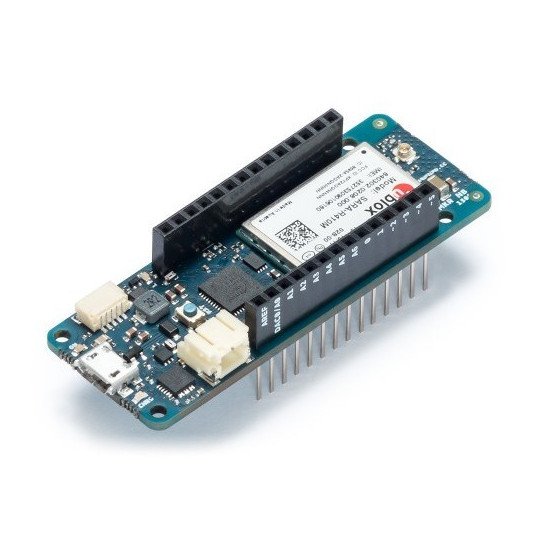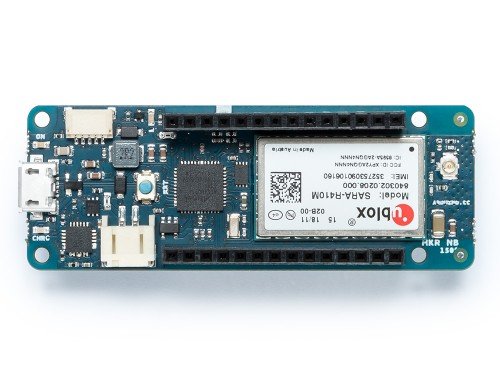Description
The module based on the systemAtmel ATSAMD21 SoCandU-blox SARA-R410M, allowing you to stay connected in the standardNarrowband-IoTandLTE Cat M1. Tile has a coreCortex-M0+,256KBFlash memory,32KB SRAM,8 digitalinputs/outputs 12 PWM channels,7 analog inputs, as well as popular communication interfaces, includingI2S. Works with a voltage of3.3 V. Designed for IoT projects. The module can be powered with battery Li-Pol 1S 3,7 V with minimum 700 mAh, or charged in the event of an external powering of the module. ATSAMW25 consists of three main blocks:
- the core SAMD21 Cortex-M0+ 32bit low power ARM MCU
- system wi-fi U-Blox Nina W10 low power 2.4 GHz IEEE 802.11 b / g / n
- ECC508 CryptoAuthentication
Key features
Below are a few features that distinguish modules Arduino compared to other programmable tiles.
| Name | Description |
|---|---|
|
Installed bootloader |
Thanks to installed bootloader, for programming the device sufficient are micro usb cableandthe software from the manufacturer's website. |
|
Small size |
This version is characterized by small size: 61.5 x 25 mm. It does not have soldered connectors. Included are strips goldpin for self-assembly. |
|
Standard NB-IoT and LTE Cat |
Arduino MKR NB 1500 features the U-blox SARA-R410M, allowing you to stay connected in the standard Narrowband-IoT and LTE Cat M1. |
|
Digital leads |
8 digital inputs/outputs allows, i.a. the control of LEDs, relays and the reading of the buttons' states. |
|
Current efficiency |
The maximum power efficiency for one lead is 7 mA. |
|
PWM outputs |
12 PWM outputs allow, for example, the control of motors and the brightness control of the LEDs. |
|
Analog inputs |
7 inputs of built-inanalog to digital converter with a resolution of 12-bits, support, i.a., sensors with analog output. |
|
Serial communication |
The device supports popular communication interfaces, i.a. UART, I2C, I2S and SPI. |
|
Built-in memory |
ChipAtmelATSAMW25 is a signal at a frequency of 48 MHz, has 256 KB of Flash memory and 32 KB of RAM SRAM. |
|
Power 5 V microUSB / battery 3.7 V |
To power the Arduino, you can usea power sourcewith a voltage of 5 V with a microUSB connector or the battery Li-Pol 3.7 V 1S with the capacity of at least 700 mAh. |
|
Charging the batteries Li-Pol |
The module has the function of powering the batteries with the voltage up to 4.2 V with an intensity of 350 mAh. |
|
Built-in led |
The connected led on pin 6, allows debugging simple programs. |
|
First run To help you get started with the module, we have prepareda tutorial that applies to the installation and first run of the Arduino environment. |
The subject of the sale is the original product for Arduino, Botland isthe official distributor of this company.
Specification
- Voltage from 3.7 V to 5 V
- Current consumption: 7 mA
- ChipAtmel ATSAMD21
- Core: Cortex-M0
- Maximum clock frequency: 48 MHz
- SRAM: 32 KB
- Flash memory: 256 KB
- I/O Ports: 8
- PWM outputs: 12
- Number of analog inputs: 7 (channels of A/C converter with 12-bit resolution)
- Serial interfaces: UART, SPI, I2C, I2S
- External interruptions
- MicroUSB slot
- JST 2.0 mm slot for connecting with a lipol battery 3.7 V
- Tile sizes: 61,5 x 25 mm
- Weight: 32 g
Useful links |













































































































































































































































































































































